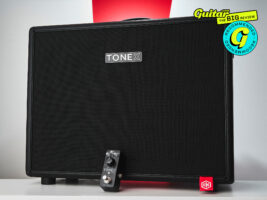
IK Multimedia Tonex One review – a complete amp solution for absolutely everyone?
€199.99 (Tonex One) & €799.99 (Tonex Cab), ikmultimedia.com
Just when you think the line between real guitar amplification and digital emulation couldn’t get any more blurry, along comes IK Multimedia and pours a bucket of molten lava over it.
Looking for a portable headphone amplifier? A device you can plug into your laptop via USB for direct recording, with instant access to multiple amp and speaker cabinet models? A jamming tool that can produce clean and dirty tones of all kinds at virtually any volume? A proper chunk of gigging backline, with channel switching, that lets you hear yourself on stage without relying on monitors? The Tonex One and Tonex Cab aim to give you all of the above, and more.
READ MORE: Blackstar ID:X 50 review: “stands out by knowing exactly what it is, and who it’s for”
Image: Adam Gasson
IK Multimedia Tonex One & Cab – what are they?
It’s probably time to stop being surprised by how much functionality can be crammed into a single pedal these days. After all, what’s going on inside the Tonex One is mostly just digital processing, so the only reason it’s as big as it is – and next to the original Tonex Pedal this thing is basically an atom – is that IK needed to make room for knobs and sockets.
So, that functionality… there is computer software involved in this package, and I’ll come to that in a minute, but it is possible to simply power up the pedal, plug in a guitar and start playing – with 20 factory presets to scroll through and plenty of scope for on-device editing. There’s a tuner built in, and you can even pick two favourite sounds then flip between them with the A/B footswitch.
That just leaves the question of what you’re plugging it into. There’s only one jack output on this pedal, but that’s not as limiting as it sounds. For a start, the USB-C port that’s used for connecting to your PC or Mac for sound-editing can also send audio from the pedal for recording; and the main output doubles as a (stereo) headphone socket. So you’re covered for silent noodling, as well as running it into a DI box, a recording interface… or an FRFR cabinet.
In case you’re not familiar with that term, it stands for ‘full range, flat response’ and means the Tonex Cab is no ordinary guitar cabinet. Like an English salad, it’s designed to be utterly characterless – that is to say, as tonally neutral as possible, with all the frequency-filtering coming from the source, so its only job is to make everything louder. And by ‘louder’ I mean an eminently giggable 350 watts of solid-state amplification.
That’s pushed through a custom Celestion 12” driver and a 1” tweeter, and there are tone controls on the top for tuning it to the room, plus various other bonus features including an aux input. You can even load IRs into the cab, which could be useful for playing with preamps that don’t have that part built in.
And so we come to the third part of the deal: the on-screen editing. IK is known for its AmpliTube emulation software, and a stripped-back SE version of that is included with the pedal along with Tonex SE and Tonex Editor. This is the free corner of a large and complex app ecosystem that includes lots of paid add-ons plus options for capturing and sharing home-recorded tones, but for the purposes of this review I’m going to stick with Tonex Editor – that’s the simple way to control the sounds being produced here.
Image: Adam Gasson
IK Multimedia Tonex One & Cab – are they easy to use?
Just looking at this pedal, you know the word ‘fiddly’ is going to come up before too long… but I’ve got to admit, IK has done a sterling job of making the Tonex One easy to operate.
For starters, if you’re plugged into a computer you don’t even need a nine-volt power supply because it can be powered through the USB port – a simple idea but a brilliant one. And here’s another: the status LED in the middle is actually a button. You can use this to change control mode for the four knobs – bass, middle, treble and volume or gate threshold, compression, reverb and gain – or, by pushing it and the footswitch simultaneously, to enter preset scrolling mode. It even changes colour. Fiddly? Yeah, a bit, but smart.
The cab is even simpler, because all you really need to do is switch it on, plug in the pedal and make sure to start with the volume at zero unless you want your eardrums to shatter like poppadoms. It has tilt-back legs for better stage monitoring, just like a Fender Twin Reverb – and, at 15kg, has the advantage of being about half that amp’s weight.
The software side is pretty straightforward too – at least once you’ve got it going. The first thing you’ll need to install if you don’t have it already is IK Product Manager, a sort of hub for managing all your IK downloads. Confusingly, the only option that showed up on my Mac was called Tonex CS; but once downloaded, this magically changed its name to Tonex SE… and turned out to contain both Tonex and Tonex Editor.
It’s a bit of a mess, to be honest, but luckily that’s not the case with the editing app itself. With the pedal plugged in, it takes just a few seconds to sync then lets you go ahead and twiddle yourself into oblivion. Changes on the desktop are instantly applied to the pedal, so you can make adjustments in real time and not have to worry about saving.
The included amp selection is not huge but covers most bases, from Marshall and Soldano to Dumble and Dr Z, and there are 16 cab models to choose from. All amps share a common control array, including parametric EQ and presence, and you even get some basic ‘studio’ effects: compression, modulation, delay and reverb.
On the subject of effects, the free software’s 20 presets include one that has a Tube Screamer in the circuit, and five stomper-only models that can be used in front of a real amp, turning the Tonex One into a sort of ‘normal’ overdrive/fuzz pedal (there’s a stompbox mode where the footswitch engages bypass instead of A/B flipping).
But I don’t want to dwell on these virtual pedals too long – partly because they’re not very good, and partly because there’s so little you can do with them. Yes, there are thousands more stompbox models you can download from IK’s ToneNet sharing site; but if you dream of stringing together a virtual pedalboard to run into your virtual amp, like you can in AmpliTube, that’s not an option here. You can’t even adjust the knobs in Tonex Editor. Forget the pedals, move on.
Image: Adam Gasson
IK Multimedia Tonex One & Cab – what do they sound like?
Shall we start with the One and Cab working together? Go on then, but just let me warn the neighbours first – because while 350W is nothing special by FRFR standards, this black box is nonetheless an absolute house-shaking beast.
In terms of sheer volume, you’ll be fine here unless you’re planning to play Wembley Stadium without a PA. Maybe it doesn’t feel exactly the same as cranking a real valve amp, but it’s big, rounded and well balanced, and sounds just as convincing at bedroom levels as it does when you’re waking babies three streets away.
Clean tones have all the top-end chime and low-end warmth you could ask for, the transition into crunch happens naturally and with no loss of conviction, and the various high-gain models are impressively tight and impactful. It’s in the heavy zone, in fact, that the Tonex One seems to be happiest of all: even if the noise gate is pretty crude, the factory presets for full-throttle Marshall, Orange, ENGL and Mesa Boogie sounds are all excellent. There’s also a Tweed Deluxe model that does the Neil Young ‘splat’ remarkably well.
Given the aforementioned limitations with virtual effects, it’s important that our teeny-weeny amp can take real pedals well – and it can, getting on famously with everything from low-gain drives to Muff-style fuzzes. I’d have no qualms about using this as a live rig with my pedalboard.
Everything above applies equally when you’re listening through headphones or desktop monitors, meaning this pedal very much lives up to its billing as a true all-round tool… and it’s worth noting that the Tonex Cab works fine without its wee friend as well: I ran a Walrus Audio ACS1 into it and was rewarded with a rainbow of top-class clean and overdriven tones.
One more clever feature to add to the list: there’s a knob on the cab’s control panel marked ‘amp tone’, which the manual says “increases the realism”. What that actually means is anyone’s guess, but it can be used to liven up the midrange in a way that’s surprisingly useful.
Image: Adam Gasson
IK Multimedia Tonex One & Cab – should I buy them?
The Tonex One is an ambitious little pedal that makes a fine job of everything it sets out to do – so if you like what you’ve read about it on the IK website, you’re unlikely to be disappointed. The Cab is more complicated because it’s quite expensive for an FRFR box, and the extra functionality you’re getting for that money isn’t necessarily going to change your life… but the two of them do look awfully cute together.
IK Multimedia Tonex One & Cab alternatives
Don’t overlook the full-size Tonex Pedal (€429.99), which offers more tweaking power (and space) without resorting to the external software. Other miniature amps worth considering range from the headphone-friendly Fender Mustang Micro Plus ($134.99/£119) to the almighty Walrus Audio Mako Series MkII ACS1 ($449/£419).
Don’t like the price tag on the Tonex Cab? The Positive Grid Spark Cab ($299/£289) is a way more affordable 140W option, while the likes of Fender, Laney, Line 6 and HeadRush all make powered FRFR cabinets now.
The post IK Multimedia Tonex One review – a complete amp solution for absolutely everyone? appeared first on Guitar.com | All Things Guitar.
Source: www.guitar-bass.net











